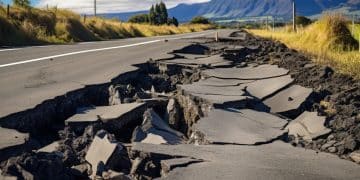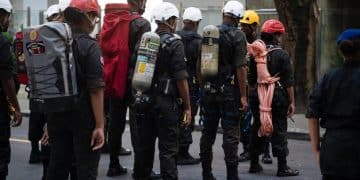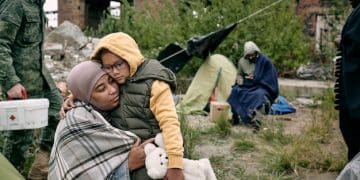First Aid Essentials: Disaster Preparedness in the US
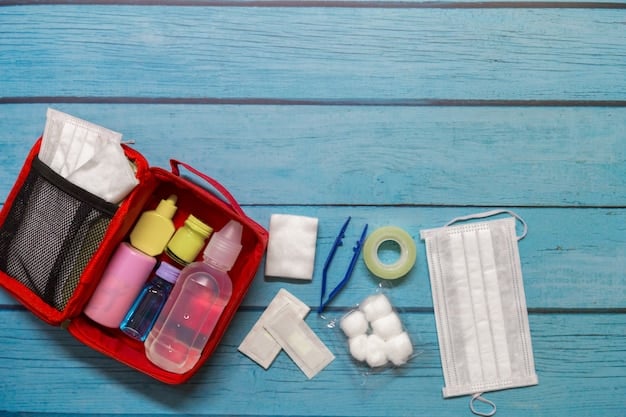
First aid essentials are crucial for every US household to effectively manage injuries during disasters, ensuring immediate care and potentially saving lives until professional help arrives.
Being prepared for a disaster means more than just stocking food and water. It also means having the knowledge and supplies to handle injuries. This guide covers the first aid essentials needed to equip yourself to handle injuries during a disaster in the US.
Understanding Disaster Risks and First Aid’s Importance
Disasters can strike anytime, anywhere. Knowing the specific risks in your region and how to respond with first aid can significantly reduce the impact of injuries. It’s about being proactive, not reactive.
Regional Disaster Risks in the US
The US faces a variety of natural disasters, each presenting unique injury risks. From hurricanes along the coasts to earthquakes in California and tornadoes in the Midwest, understanding these risks is the first step in preparing your first aid kit.
Why First Aid is Crucial During Disasters
In a disaster, emergency services may be delayed or overwhelmed. Having a well-stocked first aid kit and the knowledge to use it can provide immediate care for injuries, stabilize victims, and potentially save lives. It empowers you to act when professional help isn’t immediately available.
- Assess the most likely disasters in your region.
- Research the types of injuries associated with those disasters.
- Tailor your first aid kit and training to address those specific risks.
- Know basic first aid techniques for common injuries.
Understanding disaster risks and the importance of first aid is the foundation for effective disaster preparedness. By knowing the potential threats and having the right tools and knowledge, you can significantly improve your ability to respond to injuries during a disaster.
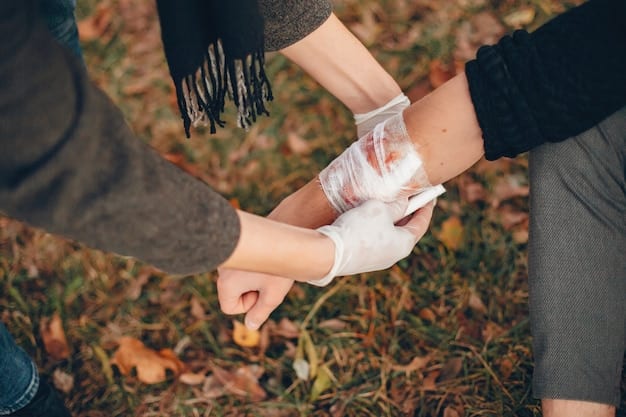
Essential Items for Your Disaster First Aid Kit
A well-stocked first aid kit is more than just a collection of items; it’s a lifeline in a disaster. Knowing what to include and how to use each item can make all the difference in an emergency.
Bandages and Wound Care
Assorted bandages, sterile gauze pads, adhesive tape, and antiseptic wipes are essential for treating cuts, scrapes, and wounds. Include different sizes and types of bandages to accommodate various injuries.
Medications and Pain Relief
Pain relievers like ibuprofen or acetaminophen, antihistamines for allergic reactions, and any personal prescription medications are critical. Ensure all medications are within their expiration dates.
Tools and Instruments
Scissors, tweezers, a CPR mask, and disposable gloves are essential tools for providing safe and effective first aid. A thermometer can also help assess the severity of an illness.
- Include a variety of bandage sizes.
- Check expiration dates on medications regularly.
- Store the kit in a waterproof, easily accessible container.
- Consider a separate kit for your car or workplace.
Having the right items in your disaster first aid kit is essential, but it’s equally important to know how to use them. Regular training and practice can help you confidently respond to injuries during a disaster.
Building Your First Aid Skills: Training and Knowledge
Having a first aid kit is only half the battle. Knowing how to use the supplies effectively is just as crucial. This goes beyond reading the instructions; it involves practical training and regular practice.
CPR and Basic Life Support
Cardiopulmonary Resuscitation (CPR) is a life-saving technique that can help maintain blood flow to the brain and heart until professional help arrives. Basic Life Support (BLS) training provides a broader set of skills for managing emergencies.
Wound Management and Infection Prevention
Proper wound cleaning, bandaging, and monitoring for signs of infection are crucial for preventing complications. Understanding how to identify and manage infections can be life-saving in a disaster situation.
Managing Common Disaster Injuries
Knowing how to treat burns, fractures, sprains, and dislocations is essential for providing immediate care during a disaster. This includes understanding how to immobilize injuries and provide pain relief.
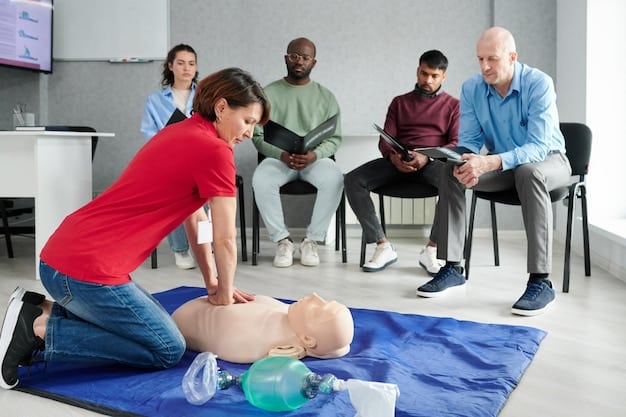
- Take a certified CPR and First Aid course.
- Attend refresher courses regularly to keep your skills sharp.
- Practice your skills with family members or in simulated scenarios.
- Learn about local resources and emergency contacts.
Storing and Maintaining Your First Aid Kit
A well-stocked first aid kit is only useful if it’s accessible and in good condition. Proper storage and regular maintenance are essential for ensuring its effectiveness during a disaster.
Choosing the Right Container
Select a sturdy, waterproof container that is easy to carry and store. A backpack or a plastic storage box with a handle works well. Make sure the container is clearly labeled as a first aid kit.
Organizing Your Kit for Easy Access
Organize the contents of your kit in a way that allows you to quickly find what you need in an emergency. Use clear labels or dividers to separate items by category. This will save valuable time when every second counts.
Medications should be stored properly, considering temperature and humidity. Keep a list of the kit’s contents and check expiration dates regularly. Replace any expired or used items immediately.
- Store the kit in a cool, dry place.
- Keep it out of reach of children.
- Check and restock your kit every six months.
- Create a checklist for kit maintenance.
Storing and maintaining your first aid kit properly ensures that it is always ready for use in an emergency. Regular checks and updates will give you confidence that you have the right supplies when you need them most.
Preparing for Specific Disaster Scenarios
Different disasters present different types of injuries. Tailoring your first aid kit and knowledge to specific scenarios can significantly improve your preparedness.
Hurricanes and Floods
Hurricanes and floods often result in injuries from debris, contaminated water, and electrical hazards. Include items like waterproof bandages, water purification tablets, and electrical safety gloves in your kit.
Earthquakes
Earthquakes can cause injuries from falling objects, building collapses, and fires. Include items like a hard hat, sturdy shoes, and a fire extinguisher in your kit.
Tornadoes
Tornadoes can cause injuries from flying debris and building collapses. Include items like a weather radio, a whistle for signaling for help, and a safe room plan in your kit.
Research the specific risks associated with each type of disaster and customize your first aid kit and knowledge accordingly. This will help you respond effectively to a wide range of emergency situations.
Preparing for specific disaster scenarios involves understanding the unique injury risks associated with each type of event. By tailoring your first aid kit and knowledge, you can be better prepared to provide immediate care and potentially save lives.
Staying Informed and Connected During a Disaster
During a disaster, staying informed and connected is crucial for receiving updates, seeking help, and coordinating with emergency services. This involves having access to reliable communication channels and knowing how to use them.
Emergency Communication Tools
A NOAA weather radio can provide real-time updates on weather conditions and emergency alerts. A battery-powered or hand-crank radio can also be used to receive information when power is out.
Creating a Communication Plan
Develop a communication plan with your family and friends, including meeting places and contact methods. Designate an out-of-state contact person who can serve as a central point of communication.
Staying informed and connected involves having access to reliable communication channels, knowing how to use them, and developing a communication plan with family and friends. This will help you receive updates, seek help, and coordinate with emergency services during a disaster.
- Sign up for local emergency alerts.
- Download emergency preparedness apps on your smartphone.
- Keep a paper map and compass in case electronic navigation fails.
| Key Point | Brief Description |
|---|---|
| 🩹 Essential First Aid Kit | Bandages, antiseptic wipes, pain relievers, and personal medications. |
| ❤️ CPR Training | Learn CPR and basic life support skills to handle emergencies. |
| 📻 Emergency Radio | Stay informed with real-time updates and emergency alerts. |
| 📍 Disaster Plan | Communicate with family and friends through a designated contact person. |
Frequently Asked Questions
▼
A basic first aid kit should include bandages, antiseptic wipes, gauze pads, adhesive tape, pain relievers, scissors, tweezers, a CPR mask, and disposable gloves. Don’t forget personal medications!
▼
It is recommended to check and restock your first aid kit every six months. Check expiration dates on medications and replace any used or expired items immediately to ensure readiness.
▼
Store your first aid kit in a cool, dry place that is easily accessible. Ensure it is out of reach of children but known to all adult members of the household for quick access.
▼
CPR training is vital as emergency services may be delayed during disasters. Knowing CPR can help maintain blood flow to the brain and heart, potentially saving lives until professional help arrives.
▼
Stay informed during a disaster by using a NOAA weather radio, signing up for local emergency alerts, and following official sources for updates. A battery-powered radio can also provide information during power outages.
Conclusion
Equipping yourself with first aid essentials and the knowledge to use them is a critical step in disaster preparedness. By understanding the risks, building your skills, and staying informed, you can significantly improve your ability to handle injuries and protect yourself and your loved ones during a disaster in the US.
